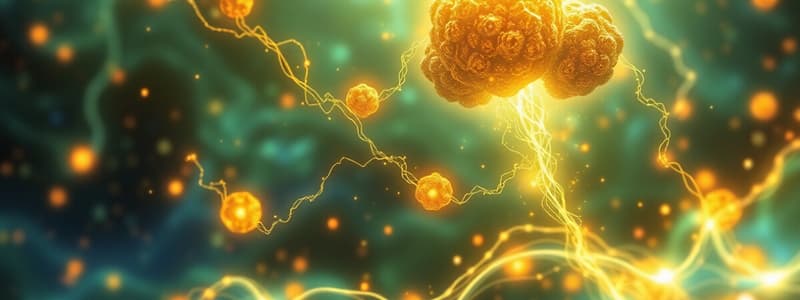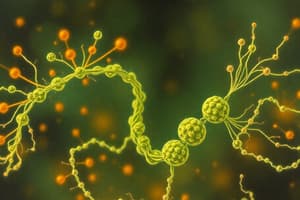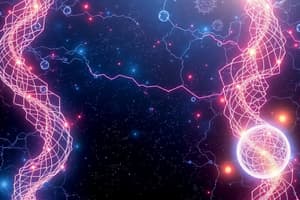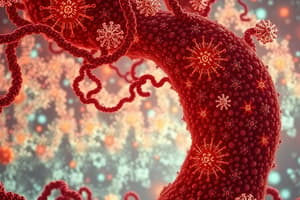Podcast
Questions and Answers
How many protons are pumped by 1 NADH during the electron transport chain?
How many protons are pumped by 1 NADH during the electron transport chain?
- 3 protons (correct)
- 1 proton
- 2 protons
- 4 protons
What is the total ATP yield from 1 mole of glucose during oxidative metabolism?
What is the total ATP yield from 1 mole of glucose during oxidative metabolism?
- 28 ATP
- 32 ATP
- 24 ATP
- 36 to 38 ATP (correct)
Which of the following processes contributes to glucose production during periods of low blood sugar?
Which of the following processes contributes to glucose production during periods of low blood sugar?
- Pentose phosphate pathway
- Gluconeogenesis (correct)
- Glycogen degradation
- Glycolysis
What is produced when NADH is transferred into the mitochondria via the Glycerol 3-phosphate Shuttle?
What is produced when NADH is transferred into the mitochondria via the Glycerol 3-phosphate Shuttle?
Which enzyme is responsible for converting pyruvate to acetyl-CoA?
Which enzyme is responsible for converting pyruvate to acetyl-CoA?
What is the main storage form of glucose in the body?
What is the main storage form of glucose in the body?
Which complex of the electron transport chain does FADH2 enter?
Which complex of the electron transport chain does FADH2 enter?
What is the primary function of the pentose phosphate pathway?
What is the primary function of the pentose phosphate pathway?
Which enzyme is involved in the irreversible step of glycolysis?
Which enzyme is involved in the irreversible step of glycolysis?
What is the key function of the malate-aspartate shuttle?
What is the key function of the malate-aspartate shuttle?
What is the primary function of glycogen in skeletal muscle?
What is the primary function of glycogen in skeletal muscle?
Which of the following statements about glycogen structure is correct?
Which of the following statements about glycogen structure is correct?
During glycogen synthesis, which molecule must glucose 1-P be activated by?
During glycogen synthesis, which molecule must glucose 1-P be activated by?
Which pathway produces ribose 5-phosphate as a main product?
Which pathway produces ribose 5-phosphate as a main product?
What is the outcome of the oxidative reactions in the Pentose Phosphate Pathway?
What is the outcome of the oxidative reactions in the Pentose Phosphate Pathway?
What type of molecules are cleaved from glycogen during its degradation?
What type of molecules are cleaved from glycogen during its degradation?
Which of these statements is true regarding the liver's role with glycogen?
Which of these statements is true regarding the liver's role with glycogen?
What does ribose 5-P produced in the non-oxidative reactions of the Pentose Phosphate Pathway contribute to?
What does ribose 5-P produced in the non-oxidative reactions of the Pentose Phosphate Pathway contribute to?
What is the main function of bioenergetics in biological systems?
What is the main function of bioenergetics in biological systems?
Which of the following indicates an exergonic reaction?
Which of the following indicates an exergonic reaction?
Which process generates ATP through the direct transfer of a phosphate group?
Which process generates ATP through the direct transfer of a phosphate group?
What is one of the end products of glycolysis?
What is one of the end products of glycolysis?
Which molecule acts as an electron carrier during oxidative phosphorylation?
Which molecule acts as an electron carrier during oxidative phosphorylation?
During which stage of glycolysis are energy invested?
During which stage of glycolysis are energy invested?
What is the primary role of the TCA cycle?
What is the primary role of the TCA cycle?
Which of the following describes gluconeogenesis?
Which of the following describes gluconeogenesis?
What occurs in the electron transport chain (ETC)?
What occurs in the electron transport chain (ETC)?
Which is an effect of a positive ΔG value during a metabolic reaction?
Which is an effect of a positive ΔG value during a metabolic reaction?
What is the effect of compartmentalization regarding pyruvate in cellular metabolism?
What is the effect of compartmentalization regarding pyruvate in cellular metabolism?
Which metabolic pathway utilizes ribose 5-phosphate?
Which metabolic pathway utilizes ribose 5-phosphate?
Which statement correctly describes the glycolysis process?
Which statement correctly describes the glycolysis process?
Flashcards
What is bioenergetics?
What is bioenergetics?
Bioenergetics is the branch of science that studies the transfer and utilization of energy in biological systems.
What does a positive ΔG indicate?
What does a positive ΔG indicate?
A positive ΔG indicates a reaction requires energy input to proceed. This is a non-spontaneous, endergonic reaction.
What does a negative ΔG indicate?
What does a negative ΔG indicate?
A negative ΔG indicates a reaction releases energy, making it spontaneous and exergonic. It can occur without external energy input.
What is ATP?
What is ATP?
Signup and view all the flashcards
What is substrate-level phosphorylation?
What is substrate-level phosphorylation?
Signup and view all the flashcards
What is oxidative phosphorylation?
What is oxidative phosphorylation?
Signup and view all the flashcards
What is glycolysis?
What is glycolysis?
Signup and view all the flashcards
What is gluconeogenesis?
What is gluconeogenesis?
Signup and view all the flashcards
What is the pentose phosphate pathway?
What is the pentose phosphate pathway?
Signup and view all the flashcards
What is glycogenolysis?
What is glycogenolysis?
Signup and view all the flashcards
What is glycogenesis?
What is glycogenesis?
Signup and view all the flashcards
What is the citric acid cycle (TCA cycle)?
What is the citric acid cycle (TCA cycle)?
Signup and view all the flashcards
What is the electron transport chain (ETC)?
What is the electron transport chain (ETC)?
Signup and view all the flashcards
What is the pyruvate dehydrogenase complex?
What is the pyruvate dehydrogenase complex?
Signup and view all the flashcards
How is metabolism regulated?
How is metabolism regulated?
Signup and view all the flashcards
Glycogen
Glycogen
Signup and view all the flashcards
Glycogenolysis
Glycogenolysis
Signup and view all the flashcards
Glycogenesis
Glycogenesis
Signup and view all the flashcards
Pentose Phosphate Pathway (PPP)
Pentose Phosphate Pathway (PPP)
Signup and view all the flashcards
Oxidative Reactions of PPP
Oxidative Reactions of PPP
Signup and view all the flashcards
Non-Oxidative Reactions of PPP
Non-Oxidative Reactions of PPP
Signup and view all the flashcards
Glycogen Synthase
Glycogen Synthase
Signup and view all the flashcards
Glycogen Phosphorylase
Glycogen Phosphorylase
Signup and view all the flashcards
What are NADH and FADH2?
What are NADH and FADH2?
Signup and view all the flashcards
What are the components of the ETC?
What are the components of the ETC?
Signup and view all the flashcards
How many protons are pumped by NADH and FADH2?
How many protons are pumped by NADH and FADH2?
Signup and view all the flashcards
How is ATP synthesized in the ETC?
How is ATP synthesized in the ETC?
Signup and view all the flashcards
What is the malate-aspartate shuttle?
What is the malate-aspartate shuttle?
Signup and view all the flashcards
What is the glycerol 3-phosphate shuttle?
What is the glycerol 3-phosphate shuttle?
Signup and view all the flashcards
What is the total ATP yield from one glucose molecule?
What is the total ATP yield from one glucose molecule?
Signup and view all the flashcards
What is glycogen?
What is glycogen?
Signup and view all the flashcards
Study Notes
Bioenergetics
- Bioenergetics is the transfer and utilization of energy in biological systems.
- Bioenergetics predicts if a process is possible; kinetics measures the reaction rate.
- Enzymes do not change the free energy change (ΔG) of a reaction.
- A spontaneous reaction has a negative ΔG.
- A nonspontaneous reaction has a positive ΔG. The reaction will not happen on its own and needs energy to proceed.
ATP production
- ATP production can occur through substrate-level phosphorylation. This is where a phosphate group is transferred from a phosphorylated intermediate to ADP to produce ATP.
- Oxidative phosphorylation is another way cells produce ATP via electron transport chain.
Carbohydrate Metabolism
- Glycolysis is a metabolic pathway that breaks down glucose into pyruvate. It produces ATP and NADH.
- Glycogen is a storage form of glucose in animals. Glycogenolysis breaks down glycogen into glucose, while glycogenesis builds glycogen from glucose.
- Gluconeogenesis is the process of synthesizing glucose from non-carbohydrate precursors.
- The pentose phosphate pathway produces NADPH and ribose-5-phosphate.
TCA Cycle
- The TCA cycle is a crucial metabolic pathway that begins with acetyl-CoA. This cycle occurs in the mitochondria of animal cells and harvests high-energy electrons from carbon fuels.
Oxidative Phosphorylation and ETC
- NADH and FADH₂ carry electrons to the electron transport chain.
- The electron transport chain is a series of protein complexes embedded in the inner mitochondrial membrane.
- The movement of electrons through the chain releases energy that is used to pump protons (H+) across the membrane. This creates a proton gradient, which is used to generate ATP by oxidative phosphorylation.
Electron Transport Chain (ETC)
- Electrons carried by NADH and FADH₂ are captured by the ETC system.
- Oxygen is reduced to water during the electron transfer process.
- Electron transport complexes pump H+ ions to create a proton gradient across the inner mitochondrial membrane. ATP is synthesized through this proton gradient by oxidative phosphorylation.
Pentose Phosphate Pathway
- The pentose phosphate pathway has two phases: oxidative and non-oxidative.
- The oxidative phase produces NADPH and Ribulose-5-phosphate.
- The non-oxidative phase generates intermediates for other metabolic pathways.
- Ribose-5-phosphate is needed for nucleotide synthesis, and NADPH is needed for anabolic reactions.
Glycogen Metabolism
- Glycogen is a storage form of glucose in animals.
- Glycogen synthesis and degradation are regulated processes. These are essential for maintaining blood glucose levels.
Glycolysis - NAD+ Regeneration
- Glycolysis needs NAD+ to convert pyruvate into different products such as lactate or ethanol. These reactions proceed when oxygen is absent because NADH must be oxidized to NAD+ for glycolysis to continue. Glycolysis cannot proceed without NAD+.
Hormonal Regulation of Glycolysis
- Insulin and glucagon are hormones that regulate blood glucose levels and affect glycolysis. Insulin enhances glycolysis and glucagon inhibits it.
Transfer of Cytoplasmic NADH to Mitochondria
- NADH generated in the cytoplasm cannot directly enter the mitochondria. Specific shuttles, like the malate-aspartate or glycerol-3-phosphate shuttles, transport reducing equivalents (electrons) into the mitochondria.
Energy Gained from 1 mol Glucose
- The complete oxidation of one glucose molecule yields a significant amount of ATP, mainly through the oxidative steps of respiration.
Gluconeogenesis
- Gluconeogenesis is the reversal of glycolysis.
- It synthesizes glucose from non-carbohydrate precursors such as lactate, amino acids, and glycerol.
Studying That Suits You
Use AI to generate personalized quizzes and flashcards to suit your learning preferences.




